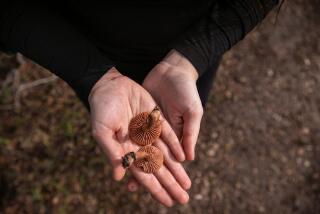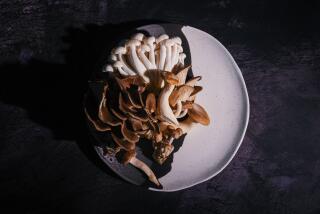Namibia’s Four-Star Fungus
- Share via
WINDHOEK, Namibia — It resembles nothing so much as a lump of desiccated donkey dung, nestled beneath the desert sands and guarded by knee-high grass and deadly puff adders. It’s difficult at first to see why people in Namibia are wild about this humble-looking fungus.
But you only need to nose into a sack of them to catch a whiff of the singular scent that inspires a seasonal passion in everyone from the poorest shack dweller to the hottest chef here: the earthy redolence of the Kalahari truffle.
Black truffles have long been prized in France, where pigs or trained dogs snuffle about under oaks to bring the treasured delicacies to market for as much as $1,200 a kilo when they’re scarce.
But in the Kalahari Desert in southern Namibia, the Nama people will sell you a couple of pounds of truffles for a few dollars or so, unless they’re keeping them to eat. The Nama call them !nabas, the exclamation mark somehow conveying the passion and excitement this fungus inspires. (In fact, it indicates a tongue click in the local language.)
The Nama recommend carrying a stout stick when truffle hunting to flip aside hissing adders, though it seems they rarely bother with such fancy precautions themselves, thrusting their hands into the dense grasses to pluck out the truffles betrayed by a small crack in the red sand.
The quest for the Kalahari truffle leads you ambling between camel thorn trees and hunting along the roadside amid bushman’s grass, which carries a surprising scent of a wine cellar.
But as much as the physical hunt, nosing out Kalahari truffles means unearthing Namibian truffle lore: advice, stories and recipes.
Outside a shabby tin shack in truffle country, an elderly Nama man’s eyes light up at truffle talk. To Krisjan Gariseb, 73, nothing else that grows on Earth tastes so good.
“It comes from the soil and it’s full of good things,” he says. “If anyone tells me there is !nabas on a farm, I’ll drop everything and go right there and get it.”
He describes the traditional cooking method: First build a hot fire and let it burn away until even the coals are gone. Then bury the truffles whole in the searing hot sand.
If you ask him how long to leave them there, he replies, smiling, “Until they’re done.”
Namibians are as inventive about Kalahari truffles as others are about the potato. They bake them, boil them, puree them, slice them raw with salt or serve cooked slices in a salad. Some barbecue them or grate them over pasta. Some fry them in lashings of butter and eat them on toast. Some recommend wrapping small ones in bacon and baking them whole. Others whisper their own secret: Cook them, but let them sit a night and eat them the next day, the flavors richer and enhanced.
They like to slice truffles into thick disks or chunky cubes, with none of the delicate shavings, thin slices, strips, trimmings and peelings that the French truffle is usually subjected to.
In Windhoek, the sleepy Namibian capital, Swiss chef Urs Gamma bounces about in front of his stove top, tossing arcs of cream-laced truffles from a pan, enthusing about their qualities, his spectacles twinkling.
Gamma, whose Restaurant Gathemann is one of the best-known restaurants in Windhoek, urges subtlety, caution: a whisper of this, a smidgen of that is all the truffle wants. But Dave Cole, the aficionado who sold Gamma his truffles, takes a more robust approach. Stick your nose over the pot on his stove top, and the fumes of mingled truffle, vodka, herbs, cream and even a dash of chili will almost flatten you.
Out in the heart of truffle country, retired schoolteacher Bess Steenkamp looks contentedly at a small mountain of truffles waiting in her kitchen to be cleaned and peeled.
“It’s a wonderful smell, isn’t it? All my friends and family are phoning with requests from all over the country: ‘You must buy! You must buy! You must buy!’ ”
Kalahari truffles, Terfezia pfeilii, are distantly related to French black truffles, but they are not as aromatic.
Unlike the black French truffle, with its hard, knobby outer layer, Kalahari truffles have a smooth brown skin like a small round potato. Like the French truffle, which is always found near the roots of oaks, the Kalahari truffle has a symbiotic relationship with a plant -- the desert melon.
Kalahari truffles are cheap in Africa because it is Africa: The collectors are often poorly paid or ask little for their goods. But if the Kalahari truffle ever found its way into the exotic street markets of Paris or Rome, it would doubtless create ripples of excitement, curious buyers and higher prices -- if not the sky-high prices of European black or white truffles.
The difficulty with exporting truffles, however, is not just their short shelf life -- about a week -- but regularity of supply. This wet-season desert fungus is widely available one year and scarce the next.
Despite the ups and downs, truffle season is always more of an event in Windhoek than it is in Paris, where truffles for many people can be a mere curiosity displayed in a glass case at a marketplace. Few in France can afford to rush out into the countryside to buy up dozens of pounds, like Cole does regularly in truffle season, returning with his head swimming from the heady perfume that fills his car.
The musky, mysterious scent of the French truffle has challenged the descriptive powers of avid epicureans and food writers. The Kalahari truffles are no different.
To call it a pungent, earthy, fungal smell, though accurate, sounds repugnant and ignores the subtle, savory perfumes and floral hints of grass that are its essence.
“What do they taste like?” says Cole, pausing and puzzling. “Like
When Dumenikus Freeman, 40, of the Nama tribe was out hunting for truffles last month, he happened upon a haul to remember for a lifetime.
In a typical season, he might walk for hours and find a few truffles. But Freeman, his wife and children, hunting in the roadside grass, were plucking out truffles every few seconds. Sitting on the ground beside his donkey cart was a sack with at least 15 pounds of truffles, and it was only midmorning.
Heavy rains had robed the Kalahari in luxuriant green this year, instead of the usual red dust, and spawned prodigious amounts of truffles, a bumper season unlike any that people can remember.
Freeman sold a few pounds, but that night he and his family feasted on truffles boiled with salt.
As Freeman collected truffles, chef Gamma had just taken delivery of a large supply in Windhoek and was planning entire truffle menus: roesti with truffle, carpaccio of raw sliced truffles with virgin oil, truffles with sole, truffles with wild game, and a sublime creation of truffle-stuffed ravioli nestling on a rich truffle puree.
Gamma, originally from Biel, Switzerland, is a self-taught chef who seeks out indigenous products and has never cooked or tasted European truffles.
The first time he bought a sack of Kalahari truffles, he had no idea what to do with them and had to call around for ideas.
“No garlic,” he says, revealing his truffle secrets. “Garlic just kills the taste. And no spices! Just a touch of dry white wine and a few herbs. If you cook them too long, they go black.”
Until there is a regular and predictable supply, bringing these Kalahari delicacies to the world market is near impossible.
Professor Varda Kagan-Zur of Ben-Gurion University in Israel has been studying the cultivation of the Kalahari truffle and melons in Namibia in an effort to commercialize them.
Cole, who belongs to a Namibian nonprofit association of development experts, the Center for Research Information Action in Africa, is helping coordinate the project, now in its final year.
He says it has had mixed results, “but we have learned quite a few good things.”
The study, underway for the better part of a decade, aims to create a predictable supply for markets and provide a livelihood for poor rural farmers.
“We’re still quite a long way off. We’ve managed to do quite a bit, but commercially it’s going to take another good three years,” Cole says.
Press him for details, and Cole gets a faraway look, cagey about the exact nature of the research on cultivation, changing the subject and finally mumbling into silence.
One fear he has is that cultivating truffles may create a viable industry for large commercial farmers and bypass small-scale, threadbare farmers.
If cultivation and commercialization remain a distant dream, the chance to try a Kalahari truffle in the here and now was irresistible.
After coming to Namibia to find the Kalahari truffle, picking them up, sniffing them, quizzing people about them and leaning curiously over many cooking pots, it was time to taste them.
In Bess Steenkamp’s barn of a kitchen, a huge meat saw stands at attention on one side, with an old metal table in the center, large enough to perform an autopsy on a bull. She starts work on her immense pile of truffles.
She peels a raw truffle and offers it with some salt. The texture is firm, the flavor nutty, buttery, earthy.
Steenkamp smiles encouragingly, letting me know it’s just the beginning of a perfect truffled evening.
She fills a pan with a prodigious quantity of butter, tosses in handfuls of carefully peeled, thickly sliced and boiled truffles, and with careless abandon pours in a river of rich cream, all the time a mysterious smile playing on her face at the joy of introducing another newcomer to the Kalahari truffle. Given the scale of her kitchen, quantity and quality go hand in hand.
“I’m going to cook a lot tonight.”
More to Read
Sign up for The Wild
We’ll help you find the best places to hike, bike and run, as well as the perfect silent spots for meditation and yoga.
You may occasionally receive promotional content from the Los Angeles Times.






